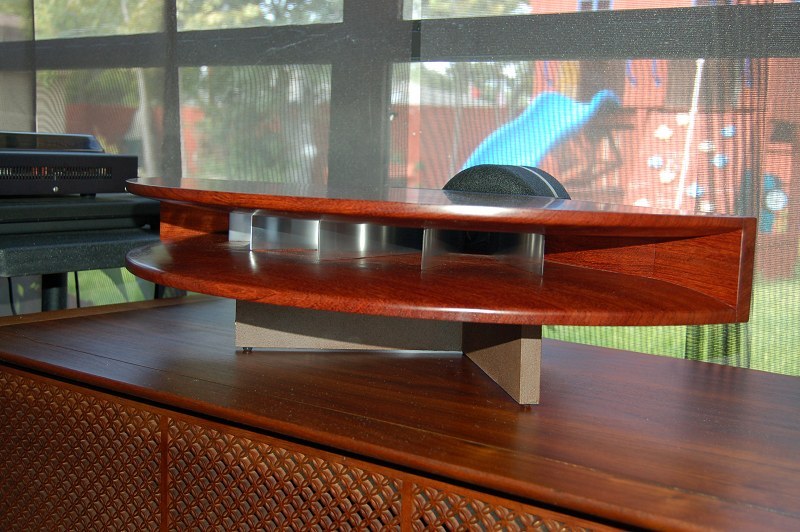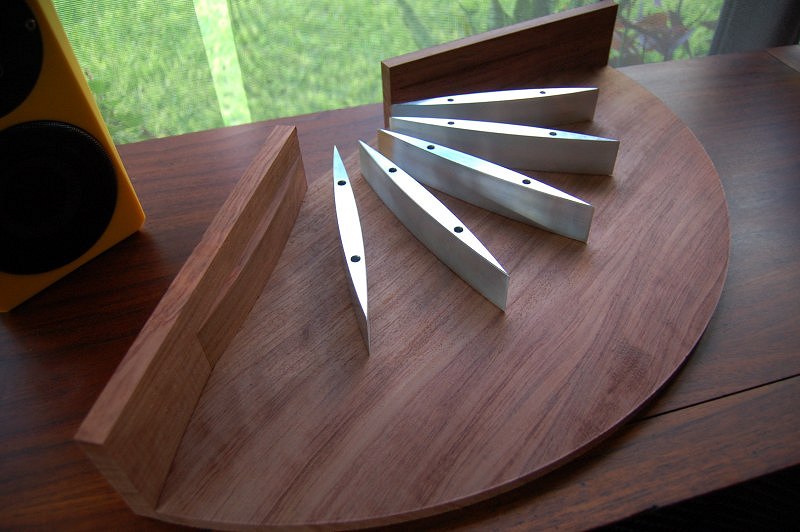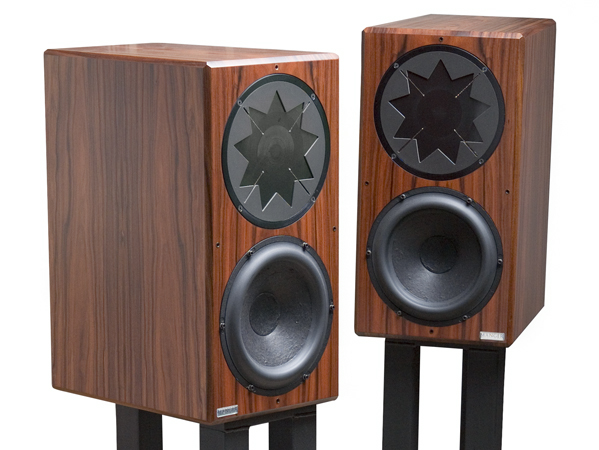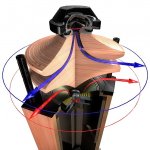I've been reading about radial horns and it strikes me that if a ~quarter of a circle works like a horn, why no just let the sound expand between two discs to create a very simple completely omnidirectional horn? Two discs with a hole in the center of one of the them, where the driver fires through. If the expansion is too fast with plain discs, it would just be a matter of putting some radial vanes in between.
This contraption could be hung on the wall to use wall loading to expand the mouth, maybe even one of the discs could be replaced by the wall?
Bogus or good idea? Prior art?
This contraption could be hung on the wall to use wall loading to expand the mouth, maybe even one of the discs could be replaced by the wall?
Bogus or good idea? Prior art?
I saw a funky horn thing today. At the museum They had two sat dishes at each end of the room. Hight on the wall. Instead of the laser they had a Peace of drain pipe about 2inches 6ft long to the floor on both ends. Kids could whisper in the pipe at one end and hear it at the other end of the room or yell for that matter. You couldn't hear it standing anywhere Else in the room. The dishes focused the sound waves to a pin point through the room.
Last edited:
The parabolic reflector thing is older than the hills, unless you are talking a real completely flat disc, then I'm intrigued.
I know about the spiral horns. What I had in mind was something even simpler and preferably loading both front and back of the driver. No spiral. just two or three discs or squares or star shapes or whatever turns out to be best, spaced close together, so horn loading will take place at the entry point of the sound.
The back loaded disc bass horn would have to be larger in diameter and be the one closest to the wall, and probably also need a disc of wool or felt to damp anything but the bass.
What I'm proposing would radically simplify horn building.
I know about the spiral horns. What I had in mind was something even simpler and preferably loading both front and back of the driver. No spiral. just two or three discs or squares or star shapes or whatever turns out to be best, spaced close together, so horn loading will take place at the entry point of the sound.
The back loaded disc bass horn would have to be larger in diameter and be the one closest to the wall, and probably also need a disc of wool or felt to damp anything but the bass.
What I'm proposing would radically simplify horn building.
That's just a regular radial horn. What I'm talking about is a disc like a giant CD you hang on the wall with spacers, with the driver mounted pointing either back or front into the hole of the "CD".
And then maybe, for mid and treble loading another smaller disc on top of the first one completely covering the driver.
This would achieve horn loading and good dispersion at all frequencies, as well as being really simple to construct.
Yes parabolic like sat dish they where sat dishes cool. I would love to see a bigger one that you sat in. I am not sure squeak what you mean. If you mean the disk is horizontal well yes It should work fine. There has been tweeter made like that I think. Two disks fanning out from the center. I sure there has been omni speakers that way too. Iam not a horn expert but Iam sure all you need is a compression chamber and a increasing area or if no chamber you have a wave guide. Does your idea have a compression chamber? omni's appeal to me as all audio sources are naturally omnidirectional.
I've been reading about radial horns and it strikes me that if a ~quarter of a circle works like a horn, why no just let the sound expand between two discs to create a very simple completely omnidirectional horn? Two discs with a hole in the center of one of the them, where the driver fires through. If the expansion is too fast with plain discs, it would just be a matter of putting some radial vanes in between.
This contraption could be hung on the wall to use wall loading to expand the mouth, maybe even one of the discs could be replaced by the wall?
Bogus or good idea? Prior art?
An externally hosted image should be here but it was not working when we last tested it.
An externally hosted image should be here but it was not working when we last tested it.


I've been thinking about building a radial horn this weekend. Here's why you might want to build one. (Bear with me, this is going to get technical and confusing)
The top two pics that I posted are of a Danley Paraline. For the most part, a Danley Paraline is a radial horn which has been folded. (Don Hills pointed out that's it's not *exactly* a radial horn, and he is correct.* But it's pretty darn close.)
The Paraline was mind-bending to me, because I never realized you could make horns that small. Having said that, I'm not 100% happy with the Paraline because there are dips in the response. I'm not 100% sure what's causing the dips, but I'm willing to bet that the reflectors in the Paraline have something to do with it.
Anyways, if my hunch is right, then we might be able to build a decent radial horn by unfolding a Paraline.
Of course, an unfolded Paraline would look a lot like a JBL 2397, which is the first and second pic above.
But I think we can make some improvements to the 2397.
Here's a list of things we might try:
1) I think the coolest part of the Paraline is the radial expansion. I am not aware of another horn which does this, except for the Duvel. I've heard Duvels, and they sound lovely. My Paraline clones sound a lot better than I'd dreamed. So there seems to be some 'secret sauce' in the radial expansion. I've heard JBL 2397 clones, and the Paraline and the Duvel sound better, at least to my ears.
2) My 'hunch' on why the Paraline sounds better than the 2397 is that there's diffraction occurring at the throat, and there are resonances which are caused by the near-constant vertical height of the 2397. (If you look at an overhead view of the 2397, you'll notice that the angle at the throat expands very very quickly, from about ten degrees to 180 degrees in the span of two or three centimeters.
An externally hosted image should be here but it was not working when we last tested it.
An externally hosted image should be here but it was not working when we last tested it.
3) To improve on the diffraction problem, it seems like it might be possible to use a reflector, a la the B&O lens (aka Sausalito Audio Works lens)
Basically put the B&O lens at the apex of the Smith horn, so that the high frequency energy is radiated evenly across the width of the Smith horn. (If you play around with a Smith horn using the waveform simulator in Hornresp, you'll notice that it becomes directional at high frequency, whereas the B&O lens does not.
Another option might be to put a Paraline at the apex of the Smith horn. Not sure if that would be an improvement though, as I'd argue that the B&O's single reflector is simpler than the Paraline's eight reflectors.
* don hills discusses paraline expansion : http://www.diyaudio.com/forums/multi-way/217298-square-pegs-39.html#post3282132
That's just a regular radial horn. What I'm talking about is a disc like a giant CD you hang on the wall with spacers, with the driver mounted pointing either back or front into the hole of the "CD".
And then maybe, for mid and treble loading another smaller disc on top of the first one completely covering the driver.
This would achieve horn loading and good dispersion at all frequencies, as well as being really simple to construct.
That'll work. You might consider two improvements:

1) put some 'teeth' on the edge of the disc, a la the Manger
The 'teeth' will change the horn tuning depending on frequency. This will have the effect of moderating the peaks and dips which are typically seen in under-sized horns. The 'teeth' won't reduce reflections from the mouth, but they *will* vary the frequency. Basically you'll still get energy reflected from the mouth, but the energy will be spread out in frequency and in time. IIRC, sharp and narrow peaks are psychoacoustically more offensive than broad narrow dips.

2) the other improvement you'll want to include is a reflector at the throat. The reflector basically re-directs the radiation 90 degrees. Without a reflector, you might get a reflection right back into the diaphragm. You can see this reflection in my 'homster' thread on this forum.
Whether you need a reflector, and what it will look like, will depend a lot on what you're driving the horn with. The BMS ring radiators are basically an ideal match for this horn, since the radiation starts out as a ring. (Easier to radiate in a ring when the radiator itself is a ring.)
This would be neat to make in a full circle.
http://www.diyaudio.com/forums/multi-way/153831-styrofoam-smith-horn.html
http://www.diyaudio.com/forums/multi-way/153831-styrofoam-smith-horn.html
- Status
- This old topic is closed. If you want to reopen this topic, contact a moderator using the "Report Post" button.
- Home
- Loudspeakers
- Full Range
- Disc horn?
